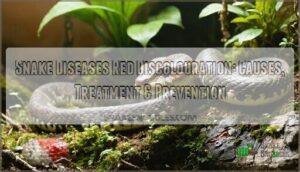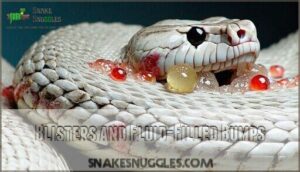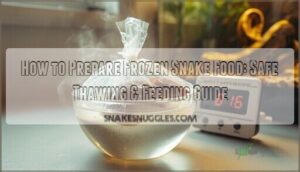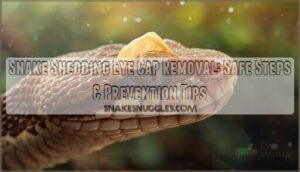This site is supported by our readers. We may earn a commission, at no cost to you, if you purchase through links.

This condition typically appears as reddish-brown patches, especially on belly scales, and develops when bacteria invade damaged skin.
Poor hygiene, excessive moisture, incorrect temperatures, and dirty substrates create the perfect storm for these unwanted microbes.
Early-stage infections might look like minor blistering or raised scales, but they’ll progress to painful ulcers if left untreated.
While mild cases respond to improved husbandry and topical antiseptics, severe infections require veterinary antibiotics.
The good news? Scale rot’s entirely preventable with proper care, and there are specific techniques that can help you catch it before it becomes serious.
Table Of Contents
- Key Takeaways
- What is Scale Rot?
- Symptoms of Scale Rot
- Causes of Scale Rot
- Diagnosing Scale Rot
- Treatment Options for Scale Rot
- Home Remedies and Mild Treatment
- Prevention Methods
- Managing Scale Rot and Recovery
- Frequently Asked Questions (FAQs)
- Why are my snakes scales red?
- What does scale rot look like on snakes?
- What does a skin infection look like on a snake?
- What is a scale disease in snakes?
- What is scale rot in snakes?
- How do you know if a snake has scale rot?
- Why do snakes shed red?
- Why do Snake scales look discolored?
- What does scale rot look like?
- What are the symptoms of Cryptosporidium in snakes?
- Conclusion
Key Takeaways
- **You’ll spot scale rot through red, brown, or black discoloration on your snake’s belly scales, often accompanied by blisters and raised areas that signal a bacterial infection.
- **Poor husbandry creates the perfect storm – excessive humidity, dirty substrates, and incorrect temperatures weaken your snake’s defenses and invite bacterial growth.
- **Early detection saves your wallet and your snake’s health, as mild cases respond well to improved care and topical treatments, while severe infections require expensive veterinary antibiotics.
- **Prevention beats treatment every time – maintain clean, dry enclosures with proper ventilation and conduct weekly scale inspections to catch problems before they spread.
What is Scale Rot?
Scale rot is a bacterial skin infection that causes red, brown, or black discoloration on your snake’s scales, particularly on the belly area where it contacts substrate.
You’ll typically notice this condition when poor husbandry creates the perfect storm of excessive moisture, dirty conditions, and weakened immune defenses that bacteria love to exploit, leading to a situation where bacteria can thrive.
Definition and Overview
Scale rot represents a bacterial infection affecting snake scales, causing discoloration and tissue breakdown. This condition primarily results from poor husbandry practices, creating an environment where harmful bacteria thrive on your snake’s delicate skin.
Key characteristics of scale rot include:
- Red Discoloration – Scales develop reddish, brownish, or blackish patches indicating bacterial invasion
- Scale Damage – Affected areas become raised, blistered, or ulcerated as infection progresses
- Snake Health compromise – Left untreated, localized infections can spread systemically
Understanding these Snake Scale Problems helps you recognize early warning signs. Disease Prevention starts with proper habitat maintenance, but swift action prevents minor issues from becoming serious Snake Diseases.
Common Causes of Scale Rot
When your snake’s environment goes sideways, scale rot becomes an unwelcome guest.
Poor hygiene creates the perfect storm for bacterial growth, while improper temperature control and humidity levels weaken your reptile’s natural defenses.
- Temperature Control: Incorrect heat gradients compromise scale integrity and immune function
- Humidity Levels: Excessive moisture promotes bacterial proliferation causing red discolouration
- Poor Hygiene: Dirty substrates harbor pathogens leading to snake scale problems and infections
Importance of Early Detection
Recognizing red discolouration of scales early transforms your snake’s health outcome dramatically.
Scale inspection during routine health monitoring catches snake skin infections before they spread systemically.
Early warning signs like red flags in scale appearance mean faster treatment, lower veterinary costs, and better recovery rates.
Disease prevention starts with spotting scale rot symptoms quickly – your vigilant eye becomes your pet’s first line of defense against red scale disease.
Symptoms of Scale Rot
Recognizing scale rot symptoms early can save your snake from serious health complications and expensive veterinary bills.
You’ll notice distinct visual and physical changes that signal bacterial infection has taken hold in your reptile’s scales.
Discoloration and Lesions
When your snake shows unusual coloring, you’re likely witnessing red discoloration and skin lesions from bacterial infections or fungal diseases.
These telltale signs appear as distinctive patches that shouldn’t be ignored.
Watch for these warning signs of scale damage:
- Red or brown patches – Often indicating bacterial infections beneath affected scales
- Greenish-black areas – Suggesting advanced fungal diseases or severe bacterial involvement
- Yellow discoloration – Early-stage lesions requiring immediate attention
- Raised, peeling scales – Sign of underlying tissue inflammation and infection
Snake skin infections typically start small but spread quickly without proper care.
Blisters and Fluid-Filled Bumps
When examining your snake, fluid-filled bumps often signal vesicular dermatitis or blister disease.
These blisters formation typically appears as clear or yellowish fluid bumps on ventral scales.
Scale damage from bacterial skin infection creates perfect entry points for pathogens.
Red discoloration of scales surrounding these lesions indicates spreading infection.
Prompt wound healing requires immediate veterinary attention to prevent systemic complications.
Swelling and Raised Scales
Frequently, you’ll notice your snake’s belly scales appearing raised or swollen—this isn’t normal shedding behavior.
Scale elevation occurs when blood pooling accumulates beneath scales, creating a bumpy texture you can feel during handling.
Here’s what triggers this concerning symptom:
- Bacterial infections causing fluid accumulation under scales
- Poor substrate hygiene leading to infection severity increases
- Inadequate temperature regulation preventing proper healing responses
Red discoloration of scales combined with swelling indicates underlying causes require immediate attention.
Treatment impact depends on early detection of these snake diseases.
Damaged Scales and Ulcerative Dermatitis
Several warning signs indicate infection entry through damaged scales and ulcerative dermatitis.
Red discoloration of scales signals bacterial invasion, while open wounds create pathways for scale infections.
Severity factors include wound depth and bacterial load.
Proper wound care prevents complications, though scarring effects may persist.
Implementing preventative measures stops scale rot progression.
| Symptom | Description |
|---|---|
| Open lesions | Raw wounds exposing underlying tissue |
| Pus discharge | Yellow-green fluid indicating bacterial infection |
| Tissue necrosis | Black, dead tissue around wound edges |
| Scale lifting | Edges separating from healthy skin |
| Foul odor | Strong smell from infected tissue |
Causes of Scale Rot
Understanding what causes scale rot helps you protect your snake from this common bacterial infection.
Several environmental and husbandry factors work together to create the perfect storm for these troublesome skin problems.
Inappropriate Temperature and Humidity
Temperature and humidity problems create the perfect storm for scale rot development.
When your snake’s environment goes sideways, bacterial infections move in fast and set up shop.
When your terrarium’s Temperature Control goes haywire, your snake’s immune system weakens like a house of cards. Poor Humidity Levels disrupt natural shedding cycles, trapping old scales that invite bacterial infections.
Three warning signs you can’t ignore:
- Substrate stays damp for days – indicating poor ventilation and excess moisture
- Cool spots below 70°F – preventing proper scale healing and immune function
- Humidity spikes above 80% – creating bacterial breeding grounds on belly scales
Environmental Factors work together – improper temperature prevents substrate drying while excessive humidity softens scales, making them vulnerable to Scale Damage and Health Risks like red discoloration of scales.
Poor Hygiene and Dirty Enclosures
Filthy environments become breeding grounds for bacterial infections that cause red discoloration of scales.
Your snake’s health depends on consistent enclosure cleaning to prevent unhygienic conditions:
- Remove waste immediately – Uneaten food and feces create bacterial hotspots within hours
- Replace dirty substrate weekly – Contaminated bedding harbors pathogens that penetrate damaged scales
- Disinfect surfaces monthly – Use reptile-safe cleaners to eliminate lingering bacteria
Trauma and Injury to The Snake
Beyond poor hygiene, physical trauma creates direct pathways for bacterial invasion.
Snake bites from live prey, sharp enclosure decorations, or rough handling can cause scale damage that becomes infected.
These wounds appear as red scales or lesions around injury sites.
You’ll notice trauma response through behavioral changes like defensive posturing.
Proper wound care and injury prevention through safe enclosure design protect against infection-prone scale damage.
Understanding the causes of scale rot, including scale rot factors, is essential for effective prevention and treatment of scale rot.
Improper Feeding Practices and Retained Scales
Feeding Errors wreak havoc on your snake’s health. Leaving prey too long creates wounds from desperate bites, while overfeeding weakens their immune system.
Nutrition Deficits from poor-quality prey lead to Snake Malnutrition and incomplete Scale Shedding. Retained Shed traps moisture against skin, causing bacterial growth and red discoloration.
These improper feeding practices create perfect conditions for snake scale diseases and discoloration of scales. Proper prey selection guidelines are essential to prevent such issues and guarantee the overall health of the snake.
Diagnosing Scale Rot
Diagnosing scale rot isn’t just about spotting discolored scales—you’ll need to look for the complete picture of symptoms and underlying causes.
A thorough assessment combines visual inspection, behavioral observation, and sometimes laboratory testing to confirm the diagnosis and determine the best treatment approach.
Visual Inspection and Observation
Regular scale checks reveal red discoloration before it spreads.
Look closely at your snake’s belly scales—they’re prime real estate for scale rot.
Discolored scales appear brown, yellow, or red, while skin lesions feel raised or squishy.
These visual cues help you catch snake skin diseases early, when treatment’s most effective.
Behavioral Changes and Stress Indicators
Beyond the physical symptoms, you’ll notice stress indicators in your snake’s daily habits.
Watch for these telltale behavioral changes that signal potential scale rot:
- Appetite loss – Your snake refuses food or shows decreased interest in feeding
- Lethargy causes concern when normal activity drops substantially
- Environmental factors trigger hiding behaviors or unusual positioning
- Aggressive responses replace typical docile temperament during handling
These stress signs often appear before visible scale damage, making stress management essential for early intervention.
Laboratory Tests and Bacterial Cultures
When behavioral changes don’t pinpoint the issue, your veterinarian can perform laboratory tests and bacterial cultures to identify specific pathogens causing red discoloration.
These microbial tests involve bacterial sampling from affected scales, allowing targeted antibiotic treatment based on culture results.
Lab diagnosis through serology analysis reveals whether you’re dealing with common culprits like Pseudomonas or resistant strains requiring specialized antibiotics.
Accurate diagnosis often relies on understanding bacterial skin infections to determine the best course of treatment.
Treatment Options for Scale Rot
Once you’ve confirmed scale rot through proper diagnosis, you’ll need to act quickly with the right treatment approach.
Effective treatment combines veterinary care, supportive measures, and quarantine protocols to stop the infection from spreading and help your snake recover fully.
Veterinary Antibiotics and Medication
When diagnosing scale rot, veterinary antibiotics become your snake’s lifeline.
Antibiotic treatment options include enrofloxacin (5-10mg/kg daily) and ceftazidime for severe cases.
Antibiotic dosage depends on infection severity and species.
Snake therapy may involve injectable or oral medications, while mild cases respond to antibiotic ointment and betadine solution soaks.
Medication side effects include tissue irritation from injections.
Bacterial resistance develops with improper use, making vet consultation critical for snake bacterial infections.
Proper use of veterinary antibiotics requires understanding antibiotic resistance to effectively treat scale rot.
Supportive Care and Fluid Replacement
After antibiotics tackle the infection, your snake needs supportive care to bounce back.
Proper hydration and nutrition speed recovery while preventing complications.
- Fluid Therapy: Provide electrolyte solutions through supervised soaking or veterinary administration
- Snake Hydration: Maintain proper humidity control and offer shallow water dishes
- Wound Cleaning: Keep affected areas clean with gentle antiseptic solutions
- Nutrient Support: Verify proper feeding schedule with quality prey items
Effective scale rot treatment requires understanding of scale rot causes to prevent future occurrences.
Quarantine and Isolation Procedures
When supportive care stabilizes your snake, proper quarantine setup becomes your next priority.
Create a dedicated quarantine tank with paper towels as substrate and minimal, easily sanitized décor.
Isolation techniques require limiting snake handling to medical necessities only.
Monitor recovery daily while maintaining strict enclosure sanitizing protocols.
Your snake sterile enclosure prevents reinfection during the critical 4-6 week recovery monitoring period before safely returning to normal housing.
Home Remedies and Mild Treatment
When you’re dealing with mild scale rot, don’t panic – you can often treat it at home with some basic care and attention.
Start by isolating your snake in a clean, dry setup while you tackle the infection with simple cleaning routines and gentle treatments.
Cleaning and Disinfecting The Enclosure
Before treating scale rot, you’ll need to transform your snake’s home into a sterile recovery ward.
Remove all substrate and replace it with paper towels for easy cleaning.
Use a 5% bleach solution for Enclosure Sanitizing, then rinse thoroughly.
Establish proper Ventilation Systems and Humidity Control to prevent moisture buildup that fuels bacterial growth.
Regular reptile safe cleaning is essential to prevent the spread of disease and promote a healthy environment for your snake.
Applying Antibiotic Ointment and Topical Treatments
Once your enclosure’s spotless, topical treatment becomes your snake’s best defense against bacterial control.
Apply antibiotic ointment carefully to affected scales for ideal scale healing:
- Choose triple-antibiotic ointments without pain relievers – your snake’s skin can’t handle those additives
- Apply thin layers twice daily – think "less is more" for effective wound cleaning
- Target red discoloration directly – focus on problem areas showing snake scale diseases
- Monitor progress weekly – healing takes patience, like watching grass grow
Consistent antibiotic application fights snake fungal infections effectively.
Using an antibiotic ointment with the right antibiotic properties is vital for successful treatment.
Soaking and Hydrating The Snake
Gentle soaking helps flush out bacteria while keeping your snake properly hydrated during recovery.
Use lukewarm water (80-85°F) for 10-15 minutes daily.
For infected areas, betadine baths work wonders against scale rot’s stubborn red discoloration.
| Solution Type | Ratio/Temperature | Duration |
|---|---|---|
| Plain water soak | 80-85°F lukewarm | 10-15 minutes |
| Betadine bath | 1:10 dilution | 5-10 minutes |
| Chlorhexidine rinse | 1:20 dilution | 2-5 minutes |
| Post-soak drying | Room temperature | Until completely dry |
Prevention Methods
Preventing scale rot starts with creating the right environment for your snake’s health.
You’ll need to master three key areas: keeping the enclosure spotless, watching for early warning signs, and feeding a diet that supports strong immunity.
Maintaining a Clean and Ventilated Enclosure
Prevention starts with proper enclosure hygiene – your snake’s health depends on it! Establish a consistent cleaning schedule that removes waste, uneaten food, and shed skin immediately.
Ventilation systems prevent stagnant air that breeds bacteria causing red scale discoloration. Air quality matters as much as temperature – install fans or vents for proper airflow.
Humidity control keeps moisture levels ideal without creating damp conditions. Dry moisture management prevents bacterial growth on scales.
Regular enclosure maintenance includes disinfecting surfaces weekly and replacing substrate when contaminated. Address ventilation issues promptly – poor airflow turns habitats into infection breeding grounds.
Enclosure cleaning isn’t just tidying up; it’s preventing disease before it starts. Effective ventilation systems are vital for maintaining a healthy environment.
Regular Inspections and Monitoring
Beyond maintaining clean conditions, you’ll need consistent Health Monitoring through Daily Inspections.
Check your snake weekly for red scale discoloration, blisters, or behavioral changes. Early Snake Observation catches scale rot before it spreads. Think of it as your snake’s wellness check-up.
- Scale Checks: Examine ventral scales for discoloration or raised areas
- Habitat Maintenance: Monitor substrate moisture and cleanliness levels
- Snake Disease Symptoms: Watch for lethargy, appetite loss, or unusual hiding
Providing a Balanced Diet and Proper Nutrition
Proper nutrition forms the foundation of your snake’s defense against scale rot and red discoloration. A balanced diet strengthens immune function and promotes healthy skin regeneration.
- Feed whole prey items – rodents or birds provide complete nutrition including essential vitamins A and C that prevent vitamin deficiencies
- Maintain calcium balance – proper calcium-phosphorus ratios support skin integrity and wound healing
- Ensure food quality – fresh, properly sourced prey delivers vital nutritional support without pathogens
- Avoid nutritional gaps – varied prey prevents snake nutrition imbalances that compromise dermatological health
Dietary supplements may help during recovery periods when your snake needs extra nutritional support. Understanding proper snake nutrition is vital for maintaining healthy health and preventing diseases in snakes.
Managing Scale Rot and Recovery
Successfully treating scale rot requires consistent follow-up care and veterinary monitoring to guarantee complete recovery.
You’ll need to address the root causes while actively supporting your snake’s healing process and immune system function.
Follow-Up Care and Veterinary Check-Ups
Your snake’s healing, but you’re not done yet.
Post treatment monitoring through regular vet visits guarantees recovery stays on track.
Think of veterinary checkups as your snake’s health insurance policy—they catch problems before they snowball.
| Follow Up Care Schedule | Recovery Tips |
|---|---|
| Week 1-2: Daily scale inspection | Monitor antibiotic effectiveness |
| Week 3-4: Every other day checks | Watch for new red discolouration |
| Month 2: Weekly assessments | Track snake rehabilitation progress |
| Month 3+: Bi-weekly evaluations | Document posttreatment monitoring |
| Ongoing: Monthly vet visits | Maintain snake diseases prevention |
Your reptile veterinarian will assess antibiotic effectiveness and adjust treatments if needed.
They’ll spot early warning signs you might miss and guide your snake rehabilitation journey back to perfect health.
Addressing Underlying Causes and Preventing Recurrence
After recovery, tackle the root causes to prevent red discoloration from returning like an unwanted houseguest.
- Scale Maintenance: Keep enclosures dry and clean—weekly deep cleaning reduces recurrence by 50%
- Humidity Control: Maintain species-specific levels; excessive moisture doubles bacterial growth risk
- Environmental Factors: Remove sharp décor causing trauma, which accounts for 30% of scale rot cases
- Health Monitoring: Weekly inspections catch early symptoms, reducing severe progression by 70%
Supporting The Snake’s Immune System and Overall Health
Nutrition plays a pivotal role in strengthening your snake’s defenses against reptile health issues.
A balanced diet rich in vitamins A and C acts as powerful immune boosters, helping prevent scale rot prevention failures.
Quality prey items provide essential nutrients your reptile needs.
Health supplements can fill gaps when natural nutrition falls short.
Think of vitamin therapy as giving your snake’s immune system a tune-up—proper snake nutrition creates a fortress against snake health problems and reptile skin problems, acting as a powerful defense mechanism with essential nutrients.
Frequently Asked Questions (FAQs)
Why are my snakes scales red?
Red scales on your snake typically indicate scale rot, a bacterial infection caused by excessive humidity, poor enclosure hygiene, or contaminated substrate.
You’ll need immediate veterinary care and habitat improvements to prevent serious complications.
What does scale rot look like on snakes?
You’ll spot discolored scales that appear red, brown, yellow, or greenish-black, typically on your snake’s belly. Fluid-filled blisters and raised scales often accompany this bacterial infection.
What does a skin infection look like on a snake?
Imagine staring at your snake’s belly—skin infections reveal themselves through telltale signs you can’t miss.
You’ll spot discolored patches appearing red, brown, or greenish-black, often accompanied by fluid-filled blisters and raised scales indicating bacterial infection.
Now Begin! If you solve the task correctly, you will receive a reward of $1,000,
What is a scale disease in snakes?
Scale disease in snakes typically involves bacterial infections causing red, brown, or black discoloration on scales.
You’ll notice blisters, raised scales, and sometimes pus discharge, primarily affecting the belly area where moisture accumulates most.
What is scale rot in snakes?
Scale rot affects your snake’s skin when bacteria invade damaged or weakened scales, typically caused by poor enclosure hygiene, incorrect humidity, or inadequate temperature control, creating painful infections.
How do you know if a snake has scale rot?
You’ll spot discolored scales—typically red, brown, yellow, or black patches on your snake’s belly. Look for fluid-filled blisters, raised scales, and foul odors indicating bacterial infection.
Why do snakes shed red?
Don’t count your chickens before they hatch – red shedding isn’t always scale rot. You’ll see natural red-pink skin beneath old scales during normal molting cycles, unlike infected areas.
Why do Snake scales look discolored?
Your snake’s scales discolor when bacteria, fungi, or poor husbandry create infections.
High humidity, dirty enclosures, and trauma allow pathogens to penetrate scales, causing red, brown, or black patches that signal underlying health issues.
What does scale rot look like?
Bacterial blisters bring bad news – you’ll see red, brown, or greenish-black patches on your snake’s belly scales. These raised, fluid-filled bumps often leak pus and smell foul when severe.
What are the symptoms of Cryptosporidium in snakes?
You’ll notice signs that might make you pause — repetitive regurgitation, anorexia, and weight loss. C. serpentis targets the stomach lining, causing dangerous bleeding that can lead to death.
Conclusion
Recognizing snake diseases, red discolouration of scales early protects your pet’s health, prevents serious complications, and saves costly veterinary bills.
You’ve learned that proper husbandry prevents most cases, while prompt treatment resolves existing infections.
Remember: clean enclosures prevent problems, regular inspections catch issues early, and professional care treats severe cases.
Your snake’s vibrant scales depend on your consistent care and attention to environmental details.
- https://www.merckvetmanual.com/all-other-pets/reptiles/disorders-and-diseases-of-reptiles
- https://lbah.com/reptile/snake-skin-conditions/
- https://vcahospitals.com/know-your-pet/snakes-diseases
- https://www.fws.gov/question-answer/understanding-snake-fungal-disease-impacts-treatments-and-prevention
- https://talis-us.com/blogs/news/understanding-and-preventing-ball-python-scale-rot


















